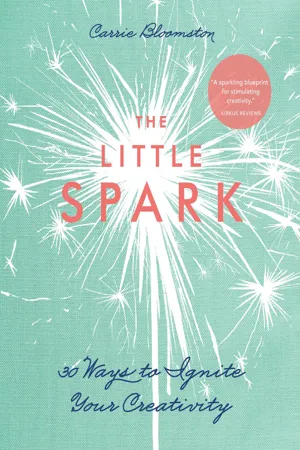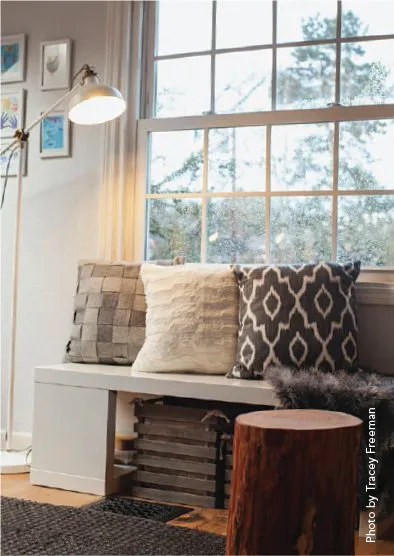![]()
Beginning is the hardest part for many creative people. I tend to procrastinate about starting any new project. I put a whole bunch of things in my way before I start: to-do lists, errands, cleaning—it’s as if I am trying to delay or defer my pleasure.
STARTING TAKES GUTS.
What if I’m terrible?
What if I fail?
What if I ruin it and waste all these materials?
You might be terrible at first. You may fail. You are definitely going to waste materials and make a mess. Then you won’t. In that order.
When you are ready to begin and you feel that fear popping up, ask yourself a simple question: “What is the worst thing that might happen if I fail, make a mess, fall on my face, waste some materials, or am terrible?” Your answer might be: “I’ll waste money that I don’t have and I won’t be able to pursue this anymore.” Or, “If I mess this up, then I’ll prove my parents (or spouse) right—that I’m not talented and I can’t do this—and I’ll be truly embarrassed.”
Do This
Write down the answer to your worst-case scenario question, in the present tense, right here.
Next, read that sentence out loud ten times to yourself, like this:
If I fail, I will prove everyone right and I will be truly embarrassed and ashamed.
If I fail, I will prove everyone right and I will be truly embarrassed and ashamed.
If I fail, I will prove everyone right and I will be truly embarrassed and ashamed.
Getting the idea? After you have said it ten times, see how you feel. If you are still really freaked out, do it ten more times. I know this sounds crazy. You may feel strange as you do this exercise. Trust me; it works. After about the tenth time (or maybe the twentieth time), you may notice that you no longer believe your sentence or that it has less power. You may notice that it isn’t true or it is extreme or you don’t relate to it. The fact is that starting is scary. It brings up fears for all of us, beginners and advanced artists alike, because we are stepping into the unknown. We have to just take that first step and know that if we do make a mess of the first ten sheets of paper that we will learn a lot on the way. The more we do, the better we get, and the easier it becomes. Here are some tips to help you over the hurdle of beginning.
TIPS FOR GETTING STARTED
Don’t Hoard Your Materials
I am an environmentalist, but I can tell you that being stingy with your materials, no matter what you are doing, will impede your process. If you are afraid of wasting paper, paint, clay, fabric, flour, or whatever, you will be limited in your exploration, especially at first. You’ve got to get in the groove. You’ve got to catch that wave before you can ride it.
Materials are your fishing pole, the doorway to your creativity. If you are stingy with them, you have less access to the ephemeral, magical stuff that is your own expression. Just as with fishing, you can’t get too hung up about whether or not you catch the big one. You aren’t after the biggest, best fish. You’re just there to fish. It truly is about the process and the journey. It takes time. Getting caught up in the beauty of your trinkets is tricky business. We all want the big fish each time we sit down to our craft. But it isn’t always possible. Some days your hands don’t cooperate with your brain. Undoubtedly, those days are where the most growth happens. Be okay with wasting materials now and then.
Do Some Warm-Ups
Before you start any project, it helps to warm up, to stretch your muscles. If you are sitting down to write, sew, or paint, you need to get in the groove.
Materials have their own language, pace, and rhythm—you have to tune your senses to their time frame and get into the language of your materials.
As I begin to paint, I usually get out a brush and ink. I will put the brush down and start moving it around—not to make a masterpiece, but to align myself with the slippery, fluid language of the ink. You can do this when quilting by stitching some loops onto scraps. My writing hero, Natalie Goldberg, advises her students to put their hand on the page and start writing. Don’t stop. Keep your hand on the page and keep it moving. In this way, you tap into yourself and get in the rhythm.
Take Baby Steps
Finally, it may help you to have little tiny goals—achievable, quick steps you can take every day until you are less intimidated by starting. You can almost avoid the big moment of starting entirely if you keep your work out and step into it a little bit every day; then it is more like doing a puzzle that’s sitting on the dining table—you just do a bit here and there. That way you aren’t starting but rather continuing a conversation you’ve already begun.
![]()
ARIZONA ARTIST CYNDI COON STORES MOUNTAINS OF MATERIALS FOR ART JOURNALING, PAINTING, AND CRAFTING ON FLOOR-TO-CEILING SHELVES. EACH BIN IS CLEARLY MARKED SO SHE KNOWS WHAT’S INSIDE.
You need a space, big or small, in which to be creative. Having a good work space cements you to your dreams. The creative space is a launchpad, refuge, retreat, temple, labyrinth, and safety net. It gives you a sense of purpose. Your space is a flagpole on the moon. If you believe in your dream enough to make a spot for it in your life and mark it with a flag, then you’re more likely to pursue your passion and hear the Spark when it calls.
Even if you’re still figuring out your creative direction, there’s an obstacle in the way if you’re always having to move everyone else’s stuff out of the way before you start. The Spark might not stick around for two hours of housekeeping. It helps to have space ready. For some, a sewing room might be a cleared-off dining table, with other materials hiding in a nearby cabinet or closet, or it might be an armchair for knitting. For others, a separate messy space might be necessary. It isn’t always possible to have a separate room, but creating a space with boundaries is important, regardless.
If you’re a baker, you may just need a bit of kitchen space, but how do you claim that space as yours and separate from your family’s? Create a special place (a drawer or cupboard) for all your stuff—tools, pans, books. Claim it as your own and don’t let it get mixed in with the daily flotsam of life. Own it. Mark it. Protect it. In this way you advocate for yourself, your pursuits, and your special creative time.
One way to claim your space is by making it beautiful. Surround yourself with beauty. It will beckon you.
CREATIVE CHAOS
When I work, a tornado quickly brews in my studio—papers, fabrics, and trash go flying in all directions. By the time I am done, my 300-square-foot studio is unrecognizable. The surfaces and floor are covered in detritus and remnants. Because I know this about myself, I want my materials behind closed cabinet doors so the room feels calm. I know I’m going to make a mess as I work, and it would feel too chaotic for me if my materials were showing. This is personal preference. I have other friends who like to see their materials so they can be inspired by them.
Surround yourself with beauty. It will beckon you.
SEWING PATTERN DESIGNER SHELLY FIGUEROA OF FIGGY’S PATTERNS CREATED THIS LOVELY NOOK BY THE WINDOW IN HER ATTIC STUDIO. LET YOUR STUDIO HAVE BEAUTIFUL MOMENTS THAT CALL YOU TO SIT AND JUST BE.
Store materials so you can get into the flow easily, so your tools are ready when you are. Organize your space in a way that suits your particular needs.
CLUTTER
Clutter doesn’t help. Even if your space is periodically messy, you don’t want it to be cluttered. It can’t be a s...





